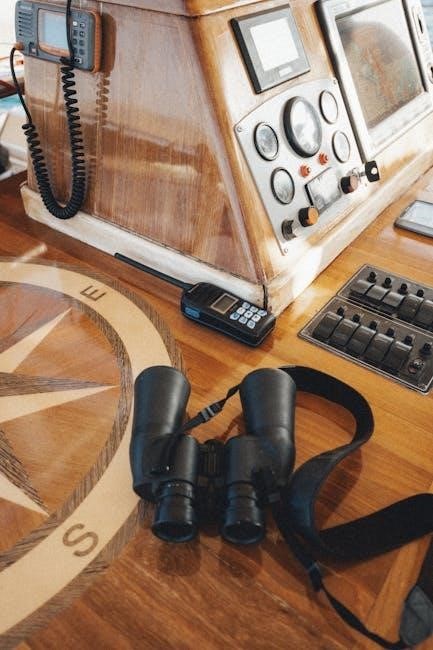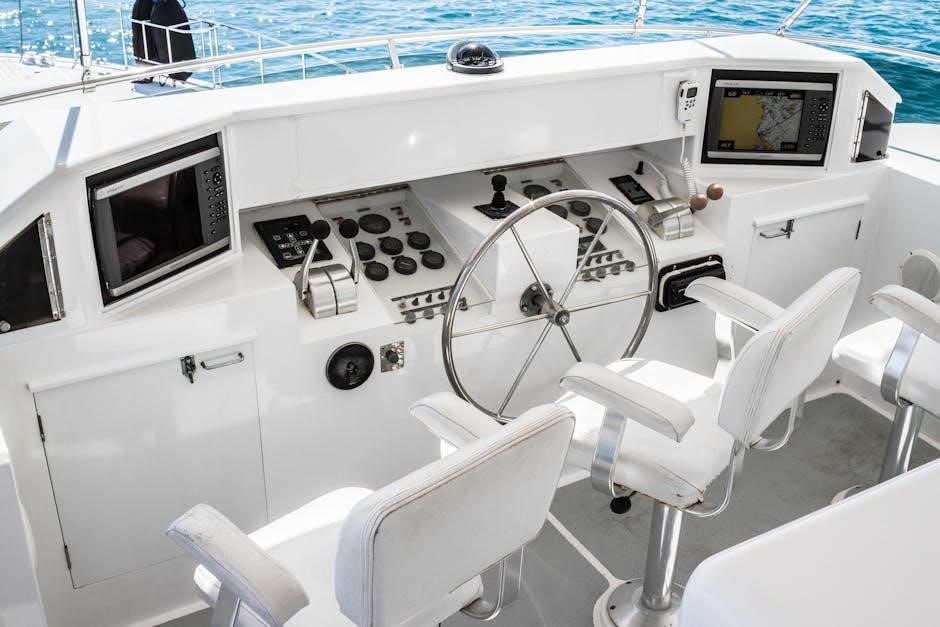vessel compass instructions
Learn how to use a vessel compass with our easy-to-follow instructions. Essential navigation tips for sailors and adventurers. Get started now!
Vessel compasses are essential navigational tools providing direction and course-setting capabilities. Their historical evolution from simple magnetic needles to advanced instruments highlights their critical role in maritime navigation.
1.1 Importance of Compasses in Marine Navigation
Vessel compasses are indispensable for marine navigation, providing accurate directional information to set and maintain courses. Proper installation ensures minimal magnetic interference and stability, crucial for reliable readings. Mounting in the fore-and-aft direction on a firm base prevents oscillation, while rubber sheets can reduce engine vibrations. A well-installed compass offers a consistent reference point, essential for navigation, especially in low-visibility conditions. Regular maintenance, including compensation, ensures accuracy, making compasses vital for safe and efficient maritime operations.
1.2 Brief History and Evolution of Marine Compasses
The marine compass has ancient origins, with early versions using lodestones to indicate direction. Its adaptation for maritime use revolutionized navigation, providing a reliable heading reference. Over centuries, the compass evolved from a simple magnetic needle to include a rotating card with degree markings. Advances in design, such as gimbal mounts and compensating balls, improved stability and accuracy. Modern compasses integrate with GPS, offering enhanced functionality while retaining the core principle of magnetic direction. This evolution underscores the compass’s enduring importance in maritime navigation.
Installation Instructions for Vessel Compasses
Mount the compass in the fore-and-aft direction, ensuring a firm base to prevent vibration. Use a rubber sheet to reduce engine interference and secure it level for accuracy.
2.1 Choosing the Optimal Location for Mounting
Selecting the right location for your vessel compass is crucial for accurate navigation. Mount it in the fore-and-aft direction, with the lubber line pointing toward the bow. Ensure the compass is positioned on a firm, stable base to minimize vibration, especially in speedboats. Place it where it is easily visible to the helmsman, below their normal line of sight, and close enough for quick reference. Avoid areas with magnetic interference, such as near engines or electronic devices. Use a rubber sheet beneath the compass to reduce engine vibrations and ensure the surface is flat and level when the boat is on an even keel.
2.2 Step-by-Step Mounting and Alignment Process
Begin by positioning the compass on a flat, level surface near the boat’s center, ensuring the lubber line aligns with the bow. Secure it using the recommended fasteners and mounts, available from marine dealers. Next, power the boat and steer a northerly course as indicated by a hand-bearing compass. Adjust the steering compass by turning the north-south screw until it points north. Finally, test the compass under various conditions to ensure accuracy and make any necessary compensations for deviation. This process ensures optimal performance and reliability.

Using the Compass for Navigation
A marine compass provides essential directional guidance, enabling sailors to set courses and navigate accurately by aligning the lubber line with chart headings.
3.1 Setting a Course on a Marine Chart
To set a course, plot your desired route on the chart using a pencil and straightedge. Align the compass’s direction-of-travel arrow with your planned heading. Ensure the lubber line points to the correct degree on the compass card. Steer the vessel so the bow aligns with the chart’s course line. Regularly check the compass heading against the chart to stay on track. This method ensures accurate navigation, especially in open waters or unfamiliar territories. Proper alignment and periodic adjustments are key to maintaining the correct course.
3.2 Reading and Interpreting Compass Headings
Reading a compass involves aligning the lubber line with the bow of the vessel. The direction-of-travel arrow points toward the intended course. Ensure the compass card is steady and free from vibration. Note the degree marking where the lubber line intersects the compass card to determine the heading. Adjust the vessel’s course to match the desired bearing, considering magnetic variation if necessary. Accurate interpretation ensures proper navigation, helping you stay on track and reach your destination safely.

Maintenance and Care of Marine Compasses
Regular cleaning and inspections are crucial for optimal performance. Ensure no magnetic interference or physical obstructions. Check stability and alignment, using a rubber base if needed to prevent vibrations.
4.1 Regular Cleaning and Inspection
Regular cleaning ensures optimal performance and longevity. Gently wipe the compass housing with a soft cloth to remove dirt or moisture. Inspect the glass for scratches or damage. Check the compass card for proper rotation and alignment. Ensure the base is secure and free from vibrations. Look for signs of magnetic interference nearby. Clean the pivot point to maintain smooth movement. Regular inspections help prevent navigational errors and ensure accuracy at sea.
4.2 Compensation and Adjustment Techniques
Compensation involves adjusting your compass to minimize magnetic deviation. Start by ensuring the compass is properly installed on a stable surface. Use a hand bearing compass to compare headings. Adjust the north-south screws to align the compass card with the magnetic heading. Test the compass on a northerly course and fine-tune as needed. Regularly check for deviation caused by nearby magnetic objects. Proper adjustment ensures accurate readings and reliable navigation. Always refer to the manufacturer’s instructions for specific compensation techniques tailored to your compass model.

Troubleshooting Common Issues
Identify deviation by comparing hand bearing compass readings with the steering compass. Adjust the north-south screws to align headings, ensuring accurate navigation. Regular testing is crucial.
5.1 Identifying and Correcting Deviation
Deviation occurs when external magnetic fields interfere with the compass, causing inaccurate readings. To identify it, compare the steering compass with a hand-bearing compass. Stand at the stern, away from magnetic objects, and take bearings of a fixed point. If discrepancies exist, adjust the compass using the north-south screws. Ensure the area is free from magnetic interference during correction. Regularly test the compass on a known north heading to verify accuracy. If issues persist, consult a professional for further calibration.
5.2 Addressing Vibration and Stability Problems
Vibration and instability can affect compass accuracy, especially on speedboats. Mount the compass on a firm, level surface and use a rubber sheet beneath it to dampen vibrations. Ensure the base is secure to prevent oscillation. Regularly inspect the mounting hardware for looseness and tighten as needed. Avoid placing the compass near engines or magnetic sources. If stability issues persist, consider using a gimbaled or suspended mounting system. Always follow manufacturer guidelines for installation and maintenance to ensure optimal performance and reliability.
Advanced Tips for Improved Accuracy
Position the compass away from magnetic sources and ensure it’s level. Use auxiliary tools like GPS for cross-referencing. Regularly calibrate and consult manuals for optimal performance.
6.1 Positioning the Compass for Minimal Magnetic Interference
Ensure the compass is placed on a flat, stable surface away from magnetic sources like engines, electronics, and metal objects. Use a rubber sheet beneath it to reduce vibration. Position it amidships for optimal performance and minimal deviation. Avoid areas near speakers, GPS devices, or other magnetic tools. Test the compass in different locations to find the spot with the least interference. Proper positioning ensures accurate readings and reliable navigation, especially in varying marine conditions.

6.2 Using Auxiliary Tools for Enhanced Navigation
Combine your compass with auxiliary tools like GPS devices, marine charts, and hand-bearing compasses for improved accuracy. GPS provides precise location data, while charts help visualize courses. Hand-bearing compasses allow precise bearings of landmarks. Use these tools together to cross-verify data, ensuring reliable navigation. Minimize magnetic interference by keeping electronic devices away. Regularly update charts and calibration of GPS. This integrated approach enhances situational awareness, especially in challenging conditions, ensuring safer and more efficient voyages.
Resources and References
Consult manuals like Cassens & Plath, Silva, and Ritchie Navigation for detailed instructions. Online courses and tutorials offer hands-on training for optimal compass use and maintenance.
7.1 Recommended Manuals and Guides
For comprehensive guidance, refer to manuals like the Cassens & Plath Overhead Compass, Silva 150 Ocean, and Ritchie Navigation instructions. These resources provide detailed installation, compensation, and maintenance procedures. Additionally, Plastimo IRIS 100 and Contest 101 manuals offer troubleshooting tips and advanced adjustment techniques. Online platforms also host tutorials and PDF guides, such as the MSC 10 satellite compass manual, ensuring optimal performance and accuracy for marine navigation. These materials are indispensable for both novice and experienced mariners seeking reliable compass operation.
7.2 Online Courses and Tutorials for Compass Use
Enroll in online courses like “Boating Basics” by Honolulu Community College, featuring Mark Kimura’s expert insights on compass installation. Platforms like Udemy and Coursera offer tutorials on marine navigation, covering compass use, chart plotting, and course-setting. Additionally, manufacturer-specific webinars, such as those by Silva and Ritchie Navigation, provide in-depth training. These resources include practical exercises and interactive tools to enhance your understanding of compass operation, ensuring confident navigation on the water.

